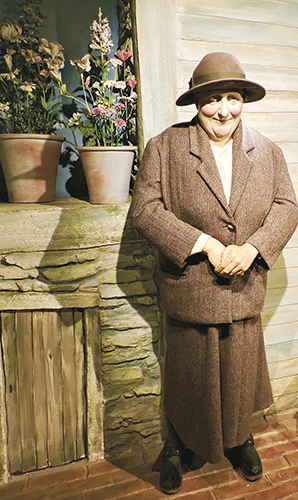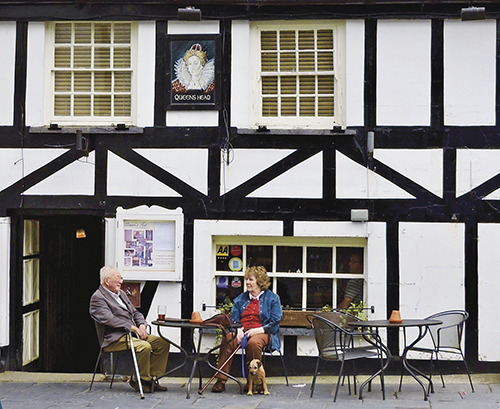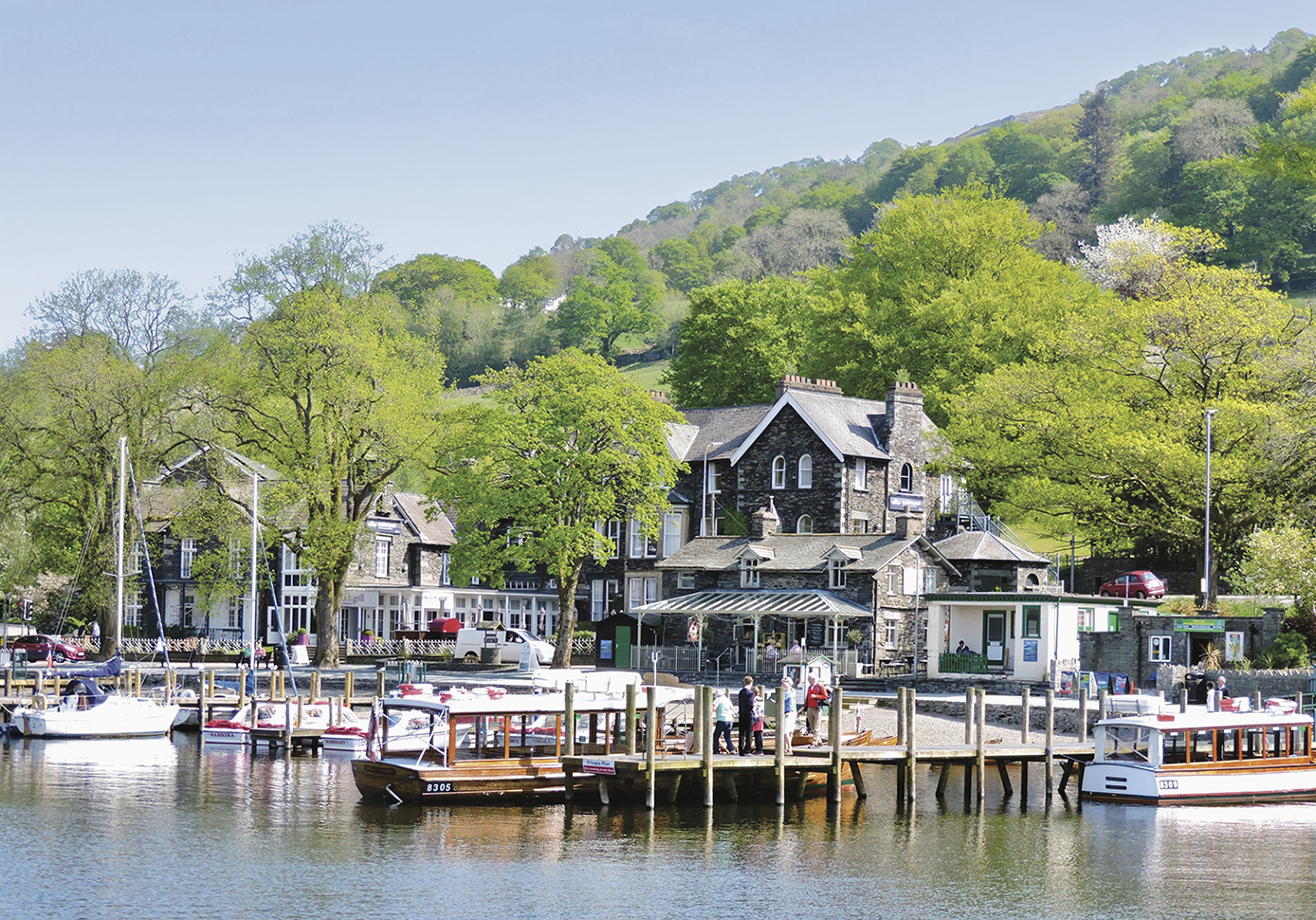Discover the landscape that inspired Beatrix Potter and William Wordsworth.
By Allan Lynch

Beatrix Potter figure at The World of Beatrix Potter, Bowness-on-Windermere.
Even today, if I flip open Beatrix Potter’s The Tale of Peter Rabbit, I can hear my mother’s voice:
“Once upon a time there were four little rabbits, and their names were—Flopsy, Mopsy, Cotton-tail, and Peter. They lived with their Mother in a sand-bank, underneath the root of a very big fir-tree.”
The words cause me to smile still.
Inspired by my memories of Peter and his adventures, I went to England’s Lake District, where Potter penned many of her beloved books.
Whether we were read to or had our imaginations shaped by our own adult reading of period novels, many of us have a mental image of rural England. For me, Lake District lived up to my imagination: it’s one of the prettiest places I’ve been. It’s a place of dreams, whether to be made there or relived. And for an anglophile like me, it’s one of the more intellectually romantic places I’ve been, that rural place of literature, movies, and imagination.
One Farm, Two Farms…
I first came to the Lake District on a fall coach tour billed as “the Best of Britain.” We pulled in for a half-day of puttering about: a quick pint in a pub, a boat ride on Lake Windermere, and a wander around Grasmere. It was so visually perfect, so deliciously like the rural England I craved, that I vowed to return.

A pet-friendly pub in Hawkshead.
Last May, I got the opportunity to revisit the Lake District. I asked a British friend, Andrew, if he would like to join me. Though he has been to the area many times, his reply was a very quick “Yes!” The Lake District is where many Brits holiday. I think that helps prove its bona fides.
We took the train from London’s Euston Station north to Lancaster, where we picked up a rental car for the hour drive north to the Lakes. Andrew saw the car and asked for something smaller. This always happens in the UK, Ireland, and the rest of Europe when you’re a North American hiring a car. Rental companies assume our preference is for large vehicles, which they imagine we drive at home.
Andrew’s reasoning was, “The Lakes get so many visitors that there’s no space to park something like this.” Since he was the primary driver, I happily bowed to his wishes.
The first hour on a major divided highway was sort of the throwaway part of the trip, but as soon as we slipped off it, we were embraced by a countryside of sheep-dotted fields divided by rambling stone walls, tree-shaded roads, hedgerows, and clusters of communities built from dark slate. Since it was May, the gardens, orchards, and countryside were waking up from winter and their blooms filled the air with a rich natural perfume of lilac and apple blossom.
We passed by Keswick, then Grasmere, Ambleside, and Windermere to Bowness-on-Windermere. There are more communities in the Lake District, but we were fixated on a strict Beatrix Potter theme.

Lake Windermere. Photo: iStock/ChrisAt.
Potter came to the Lakes as a child on holidays with her family. At the age of 30, still on holiday with her parents, she discovered Near Sawrey, which she wrote in her diary “was as nearly perfect a little place as I have ever lived in.” She so loved the area that when her books began to make money, she bought a farm—Hill Top—there. And then she bought another. And yet another. It helped that she met (and eventually married) a local lawyer, William Heelis, who knew of farmers in distress or ready to sell up. In total, Potter purchased and then left 4,000 acres (16 square kilometres) and 14 farms (all still working) to the British National Trust.
Her bequest was one of the largest for the trust, which now manages one-quarter of the land in the Lakes, protecting it from land speculation and overdevelopment. There are no high-rises, big-box stores, or chain hotels obliterating the views. Everything is Edwardian in size, bespoke and local. The bulk of the businesses are locally owned. Many items for sale are made locally. The food on plates is from local farms, gardens, and fisheries. The Lake District is a prime example of the power of the pen, since it was a pen and paintbrush in the hands of the right woman that have protected the area.
Peter Rabbit and Friends
Were Potter and her literary neighbour, William Wordsworth, to return today, they would not find the Lakes alien—a fact that makes it so attractive today that 16 million people visit the Lakes every year. Don’t be put off by that number. It means the area is capable of handling crowds. While my two visits bookended summer, there were people about, but not in overwhelming numbers. There were just enough to add interest and keep shops, pubs, cafés, restaurants, and attractions open.
I know people who regularly do walking and hiking holidays in the Lakes. They spend a week or a month roaming the fells, fields, and forests on well-marked paths. It seems a gentle way to engage in an active holiday.
To keep with our Beatrix Potter theme, we stayed at Lindeth Howe Country House Hotel in Bowness-on-Windermere. Lindeth Howe was where Potter often summered and where she illustrated two of her books. Then in 1915, on the death of her father, she bought the house for her mother. By this time, Potter already owned Hill Top.
Down in Bowness-on-Windermere itself is a large slate building housing The World of Beatrix Potter attraction. With purity of purpose, we set aside any embarrassment at not having a child as an excuse to enter and toured the site. If you have kids, you especially can’t miss it; it’s a squeal-inducing must stop. For adults, it’s a three-dimensional trip though the pages of your earliest reads.
Detailed child-height dioramas recreate scenes from The Tale of Jemima Puddle-Duck, The Tale of Mrs. Tiggy-Winkle, The Tale of Two Bad Mice, and other stories. In total, there are 19 areas, including the outdoor Peter Rabbit Garden.

The Peter Rabbit Garden.
The garden is an elevated walled patio containing many of the plants and vegetables mentioned in Potter’s books. It made me realize that, while I grew up surrounded by farms, many children today are disconnected from where vegetables come from, only vaguely aware that there is a place beyond a grocery store. So this is part of the learning experience for them. Animal kindness was also worked into the displays, showing how to be helpful to hedgehogs, butterflies, and bees.
We skipped the theatre and tea room, but the gift shop reminded me what a clever businesswoman Potter was. She embraced all kinds of marketing opportunities to generate the sale of dolls, playhouses, puzzles, and games. I’m sure she’d approve of the world of toys, trinkets, and souvenirs inspired by her work that are on sale here and throughout the community. When I saw a full-size figure of Potter in her tweeds and hat, it occurred to me that she could have picked up work as a stand-in for Miss Marple.
Photos: Allan Lynch.




